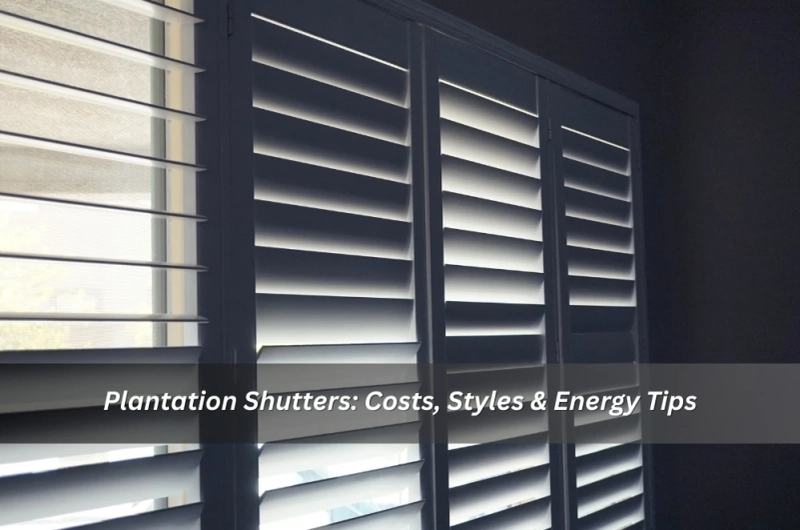Thinking about window upgrades that actually work in Aussie conditions? Plantation shutters hit a rare sweet spot: tidy lines, long service life, proper light control and less faff than fabric. If you’re scoping budgets, sanity-check the custom plantation shutters cost, so you’re comparing like-for-like on materials, finishes and installation.
What plantation shutters do (and don’t)
Adjustable louvres give fine-grained control over daylight, glare and privacy. Tilt down to block harsh western sun; crack them in winter to catch soft northern light. They’re robust too—no sagging hems or dust-heavy drapes—and easy to wipe clean, which helps in allergy-sensitive homes.
They’re not miracle workers. Shutters can trim heat gain and temper drafts, but they’re not a substitute for double glazing or good external shading. Think of them as the “last metre” of control on the inside face of the window.
Upsides at a glance
- Precise control of light and privacy
- Easy to clean; durable in high-traffic rooms
- Timeless look (classic or modern, depending on blade size)
- Works with most window types when framed well
A quick, real-world moment
I helped a mate spec shutters for a rental. The living room was cooked every arvo. We trialled blade angles at different hours, then added external shade later. The result wasn’t just prettier; the late-day glare stopped, and the room felt a full notch calmer.
Costs: What actually drives the price
Quotes move with material, opening style, finish and install complexity. A small, standard window in PVC/composite can be surprisingly affordable. Scale up to custom timber with stains, shaped bays and tracks, and the number climbs.
Cost levers you can control
- Material: PVC/composite at the lower end; timber and aluminium at the premium end
- Blade size: larger blades cost more but improve sightlines on big spans
- Frames & openings: Z-frames to hide crooked plaster, sliders/bi-folds for wide doors
- Finish: textured paints, deep stains and colour-matching add time
- Complexity: out-of-square reveals, stair voids and bay angles add labour
A tidy bundle example
For a three-bed brick veneer, we priced: six standard windows, a wide living span and a wet area. PVC in bathrooms/laundry, painted timber in living, simple hinges everywhere—mid-range. The budget wobble wasn’t the panels; it was templating a slightly racked bay and adding a shallow pelmet to level the sightline. Worth doing. The room reads intentional instead of “close enough”.
Materials: Where each shines
PVC / composite
Moisture-friendly and tough. Great for kitchens, bathrooms and laundries. Modern composites are rigid and resist yellowing if you choose reputable suppliers.
Pros: water-ready, low maintenance, budget-friendly.
Cons: thermal expansion on big spans; watch quality.
Timber
Light, strong, and beautiful under paint or stain. Basswood or poplar are common for stability.
Pros: premium finish, warm feel, lighter panels for wide openings.
Cons: needs care in humid rooms; requires maintenance over time.
Aluminium
Sleek, dimensionally stable and ideal for big door spans or alfresco zones with the right powder coat.
Pros: strongest option; minimal upkeep; crisp lines.
Cons: higher upfront; can feel cool unless softened with texture.
Room-by-room picks
- Wet zones: PVC or aluminium.
- Living/dining: timber for warmth; aluminium for huge sliders.
- Kids’ rooms: PVC or painted timber—wipeable and sturdy.
Energy and comfort: Making shutters pull their weight
Used well, shutters cut summer glare and help retain warmth at night. Government guidance on shading notes that adjustable louvres and window coverings are key parts of passive comfort. For the big-picture view, review energy-efficient plantation shutters as part of a whole-home strategy.
Practical operating habits
- Summer days: shut louvres on sun-struck glass before the room heats
- Summer nights: open for cross-flow where it is secure to do so
- Winter days: angle to admit low sun, warming internal surfaces
- Winter nights: close fully to reduce drafts across leaky frames
Pairings that work
Exterior shade (eaves/awnings) blocks heat before it hits glass; shutters then fine-tune comfort. On east/west windows, this combo is a day-to-day game-changer.
Styles and layout details that matter
Blade size: 63–89 mm is common. Bigger looks modern and keeps views open; smaller suits heritage trims.
Frame style: L-frame for inside mount, Z-frame to hide wonky plaster lines.
Opening type: Hinged for small windows; sliders or bi-folds for doors.
Mid-rails: Add strength to tall panels and let you split tilt for privacy/light.
Another quick field note
In a narrow terrace, we swapped hinged panels for top-track sliders on a wide opening. Furniture could sit tight to the reveal, traffic flowed better, and the space felt less cramped. We also chose a Z-frame to mask a 5–6 mm sill skew—instantly neater.
Maintenance and longevity
- Dust lightly, often: a weekly microfibre pass stops grime from binding.
- Wipe, don’t soak: a damp cloth for sticky spots; avoid harsh chemicals.
- Check tension: if a louvre droops, ask about tension pins.
- Mind moisture: in steamy rooms, leave blades slightly ajar when not in use.
If you’re mapping tricky rooms, line up ideas for indoor shutters for bay windows. Bays can look brilliant with the right frame combo and rail placement.
Buying smart: Quotes, lead times and installation
Specify apples to apples. Lock blade size, material, colour, opening type, frame profile and any mid-rails so suppliers price the same spec.
Ask lead times. Imported panels can vary; local fabrication may speed up odd sizes.
Measure properly. Professional templating captures reveal depth, bow and squareness.
Plan install day. Tall ladders, stair voids and door traffic need forethought; sliders require clean, level tracks.
DIY vs pro
Confident DIYers can handle small inside-mounts. Large spans, bays and anything near stairs deserve a pro. One mis-measured bay angle becomes gaps, binding panels and a constant reminder you should’ve called a tradie.
Design extras worth the spend
- Split tilts: move upper and lower louvres independently
- Track sliders: best for wide openings without door swing clashes
- Colour strategy: match architraves for calm; contrast for drama
- Light control: slim pelmets and sill caps tidy edges and cut light bleed
For an unbiased deep dive into thermal performance, read up on the plantation shutters' insulation value. Pair neutral research with supplier specs to separate marketing fluff from meaningful gains.
FAQ (quick hits)
Are shutters good for energy bills? They help when used with smart shading habits—close against afternoon sun, open for cross-flow at night—and they reduce radiant heat from sun-struck glass. Best results come when paired with external shade and decent seals.
PVC vs timber—what lasts longer? In wet zones, PVC wins. In living areas, painted timber looks premium and is light for big panels. Aluminium is the go-to for strength and outdoor-adjacent spans.
What louvre size should I pick? 89 mm feels modern and keeps views open; 63 mm suits traditional trims and fine privacy control. Test a sample in your actual window.
Do shutters work with bays or tilt-and-turns? Yes, with the right frame and hinge/track set-up. Bays often need a template and sometimes mixed hinge/slider panels to avoid clashing.
How do I keep them clean? Dust weekly, wipe as needed, and avoid soaking. In salty coastal air, a fresh-water wipe on hardware now and then helps.
Final thoughts
Plantation shutters do three jobs well: tame glare, protect privacy and finish a room with clean lines. If you want comfort gains too, treat them as part of a whole-home plan—external shade first, then glazing and ventilation—with shutters as your fine-tuning tool. Start by prioritising rooms and daylight issues, get two like-for-like quotes, and test samples in real light. When it’s time to price and shortlist, benchmark the cost of custom plantation shutters, and keep YourHome's take on energy-efficient plantation shutters handy. Make choices you’ll maintain, and your shutters will earn their keep through summer scorchers and winter chills alike.


